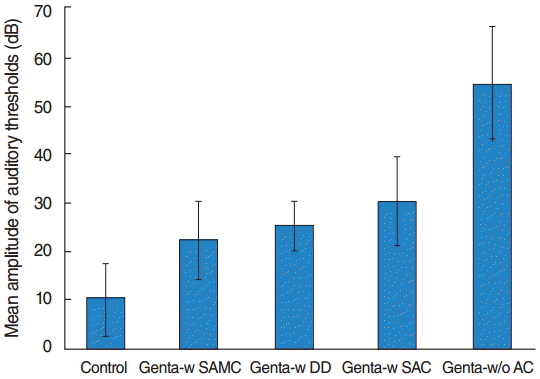1. Schacht J. Aminoglycoside ototoxicity: prevention in sight? Otolaryngol Head Neck Surg. 1998; May. 118(5):674–7.

2. Wu WJ, Sha SH, Schacht J. Recent advances in understanding aminoglycoside ototoxicity and its prevention. Audiol Neurootol. 2002; May-Jun. 7(3):171–4.

3. Oliveira JA, Canedo DM, Rossato M, Andrade MH. Self-protection against aminoglycoside ototoxicity in guinea pigs. Otolaryngol Head Neck Surg. 2004; Sep. 131(3):271–9.

4. Feldman L, Efrati S, Eviatar E, Abramsohn R, Yarovoy I, Gersch E, et al. Gentamicin-induced ototoxicity in hemodialysis patients is ameliorated by N-acetylcysteine. Kidney Int. 2007; Aug. 72(3):359–63.

5. Maldonado PD, Barrera D, Medina-Campos ON, Hernandez-Pando R, Ibarra-Rubio ME, Pedraza-Chaverri J. Aged garlic extract attenuates gentamicin induced renal damage and oxidative stress in rats. Life Sci. 2003; Oct. 73(20):2543–56.

6. Pedraza-Chaverri J, Maldonado PD, Medina-Campos ON, OlivaresCorichi IM, Granados-Silvestre MA, Hernandez-Pando R, et al. Garlic ameliorates gentamicin nephrotoxicity: relation to antioxidant enzymes. Free Radic Biol Med. 2000; Oct. 29(7):602–11.
7. Takumida M, Popa R, Anniko M. Free radicals in the guinea pig inner ear following gentamicin exposure. ORL J Otorhinolaryngol Relat Spec. 1999; Mar-Apr. 61(2):63–70.

8. Sergi B, Fetoni AR, Ferraresi A, Troiani D, Azzena GB, Paludetti G, et al. The role of antioxidants in protection from ototoxic drugs. Acta Otolaryngol Suppl. 2004; May. (552):42–5.

9. Rietz B, Isensee H, Strobach H, Makdessi S, Jacob R. Cardioprotective actions of wild garlic (allium ursinum) in ischemia and reperfusion. Mol Cell Biochem. 1993; Feb. 119(1-2):143–50.

10. Singh SP, Abraham SK, Kesavan PC. In vivo radioprotection with garlic extract. Mutat Res. 1995; Dec. 345(3-4):147–53.

11. Ide N, Matsuura H, Itakura Y. Scavenging effect of aged garlic extract and its constituents on active oxygen species. Phytother Res. 1996; Jun. 10(4):340–1.

12. Pedraza-Chaverri J, Gonzalez-Orozco AE, Maldonado PD, Barrera D, Medina-Campos ON, Hernandez-Pando R. Diallyl disulfide ameliorates gentamicin-induced oxidative stress and nephropathy in rats. Eur J Pharmacol. 2003; Jul. 473(1):71–8.
13. Maldonado PD, Barrera D, Rivero I, Mata R, Medina-Campos ON, Hernandez-Pando R, et al. Antioxidant S-allylcysteine prevents gentamicin-induced oxidative stress and renal damage. Free Radic Biol Med. 2003; Aug. 35(3):317–24.

14. Iqbal M, Athar M. Attenuation of iron-nitrilotriacetate (Fe-NTA)-mediated renal oxidative stress, toxicity and hyperproliferative response by the prophylactic treatment of rats with garlic oil. Food Chem Toxicol. 1998; Jun. 36(6):485–95.
15. Pedraza-Chaverri J, Barrera D, Maldonado PD, Chirino YI, Macias-Ruvalcaba NA, Medina-Campos ON, et al. S-allylmercaptocysteine scavenges hydroxyl radical and singlet oxygen in vitro and attenuates gentamicin-induced oxidative and nitrosative stress and renal damage in vivo. BMC Clin Pharmacol. 2004; Apr. 4:5.

16. Uzun L, Balbaloglu E, Akinci H. Garlic-supplemented diet attenuates gentamicin-induced ototoxicity: an experimental study. Ann Otol Rhinol Laryngol. 2012; Feb. 121(2):139–43.

17. Seckiner I, Bayrak O, Can M, Mungan AG, Mungan NA. Garlic supplemented diet attenuates gentamicin nephrotoxicity in rats. Int Braz J Urol. 2014; Jul-Aug. 40(4):562–7.
18. Rybak LP, Ramkumar V. Ototoxicity. Kidney Int. 2007; Oct. 72(8):931–5.

19. Amagase H. Clarifying the real bioactive constituents of garlic. J Nutr. 2006; Mar. 136(3 Suppl):716S–725S.

20. Guo Z, Muller D, Pentz R, Kress G, Siegers CP. Bioavailability of sulphur-containing ingredients of garlic in the rat. Planta Med. 1990; 56:692–3.

21. Lachmann G, Lorenz D, Radeck W, Steiper M. The pharmacokinetics of the S35 labeled labeled garlic constituents alliin, allicin and vinyldithiine. Arzneimittelforschung. 1994; Jun. 44(6):734–43.
22. Xiao D, Pinto JT, Soh JW, Deguchi A, Gundersen GG, Palazzo AF, et al. Induction of apoptosis by the garlic-derived compound S-allylmercaptocysteine (SAMC) is associated with microtubule depolymerization and c-Jun NH(2)-terminal kinase 1 activation. Cancer Res. 2003; Oct. 63(20):6825–37.
23. Sumioka I, Matsura T, Kasuga S, Itakura Y, Yamada K. Mechanisms of protection by S-allylmercaptocysteine against acetaminophen-induced liver injury in mice. Jpn J Pharmacol. 1998; Oct. 78(2):199–207.
24. Sumioka I, Matsura T, Yamada K. Therapeutic effect of S-allylmercaptocysteine on acetaminophen-induced liver injury in mice. Eur J Pharmacol. 2001; Dec. 433(2-3):177–85.

25. Egen-Schwind C, Eckard R, Kemper FH. Metabolism of garlic constituents in the isolated perfused rat liver. Planta Med. 1992; Aug. 58(4):301–5.






 PDF
PDF Citation
Citation Print
Print


 XML Download
XML Download